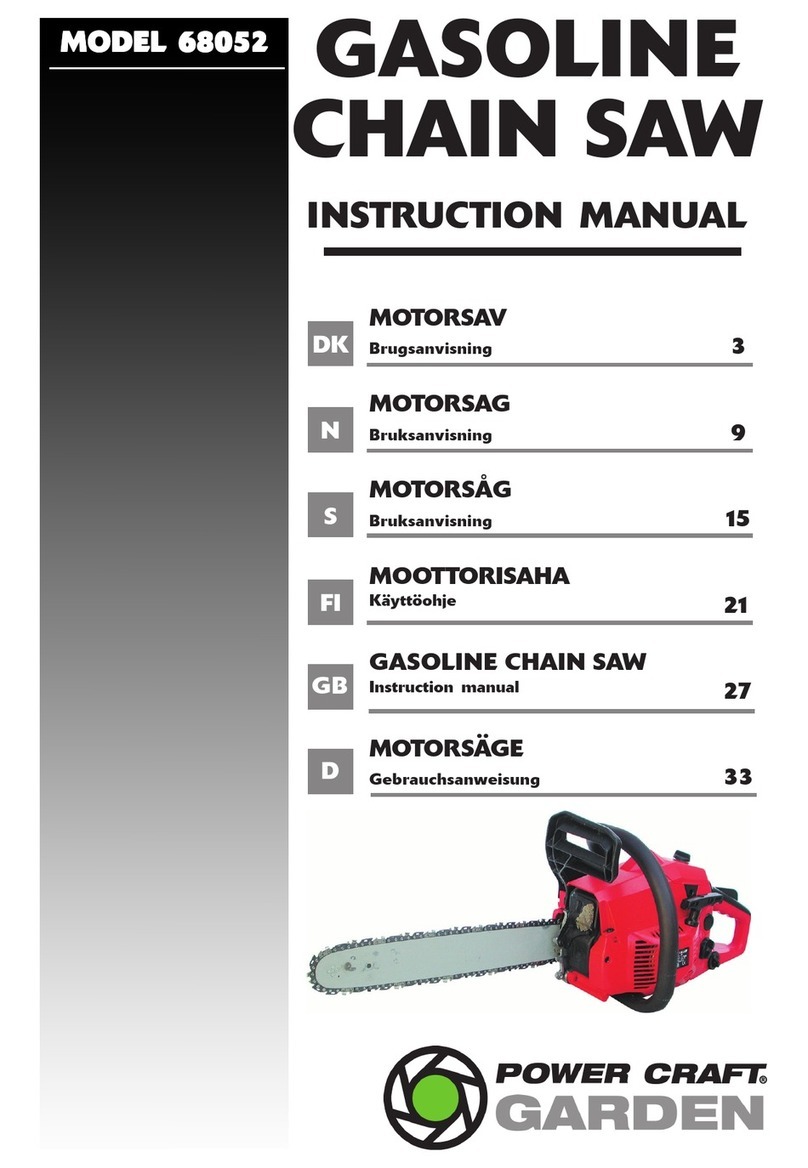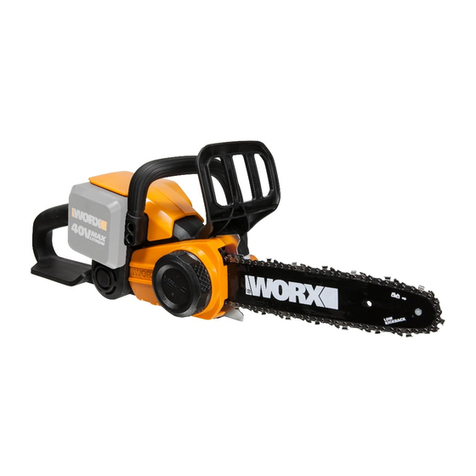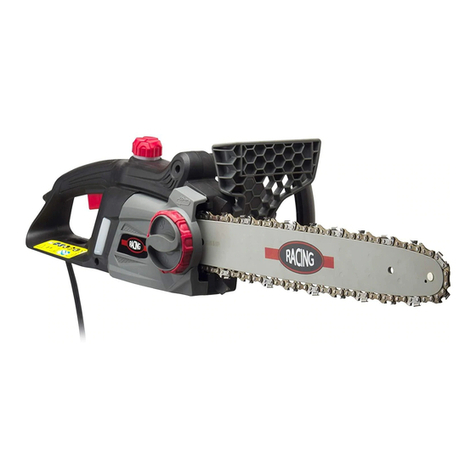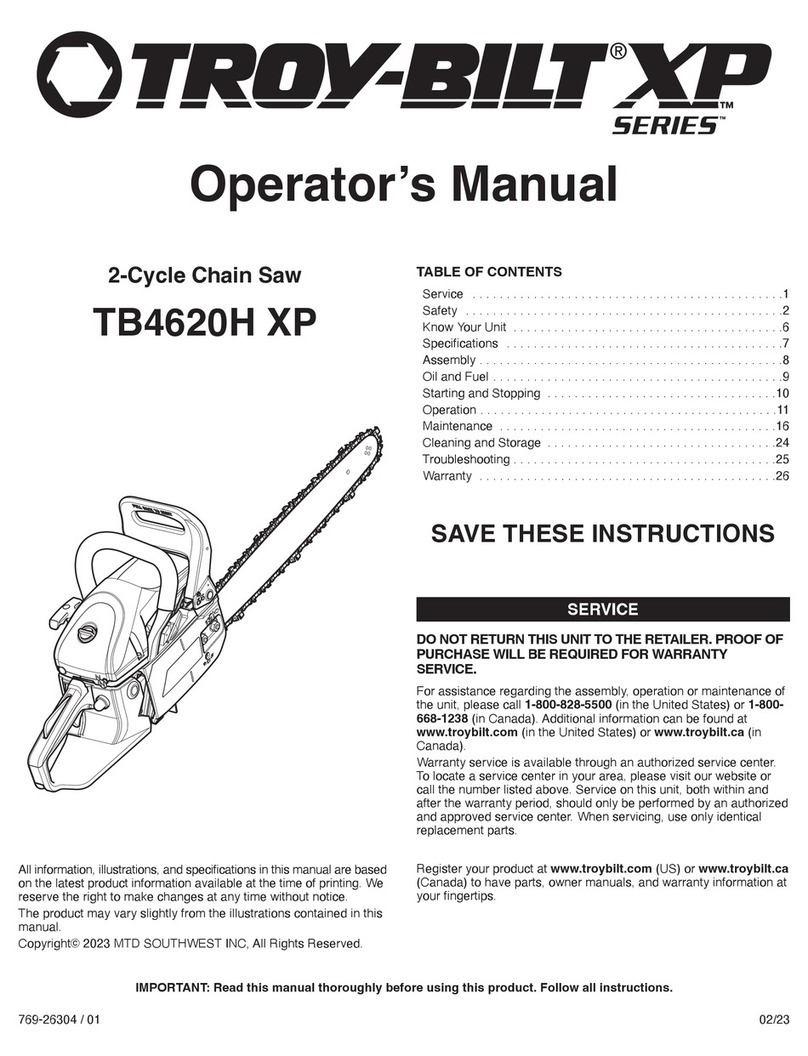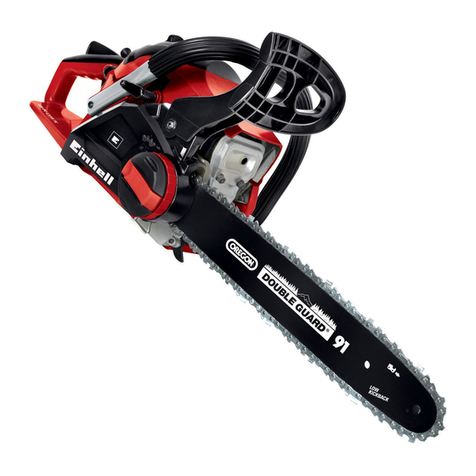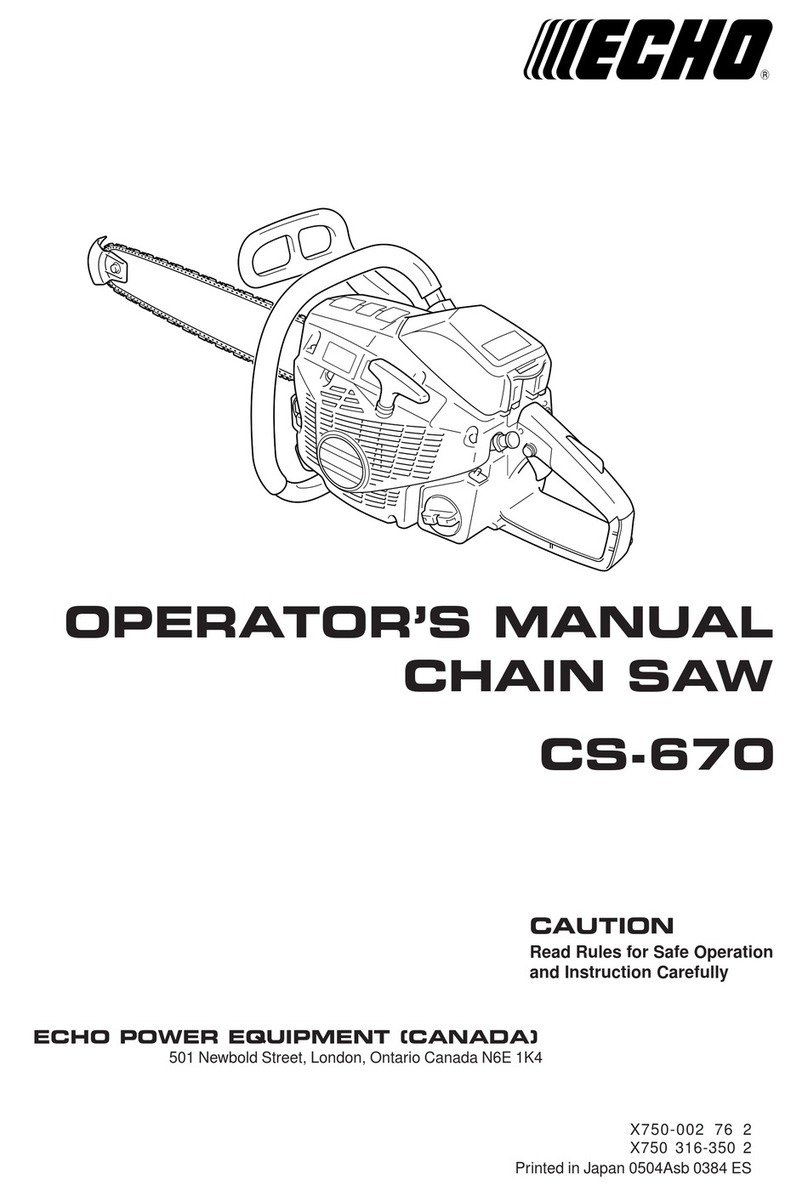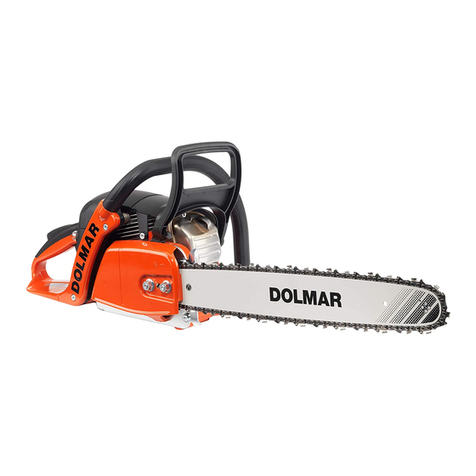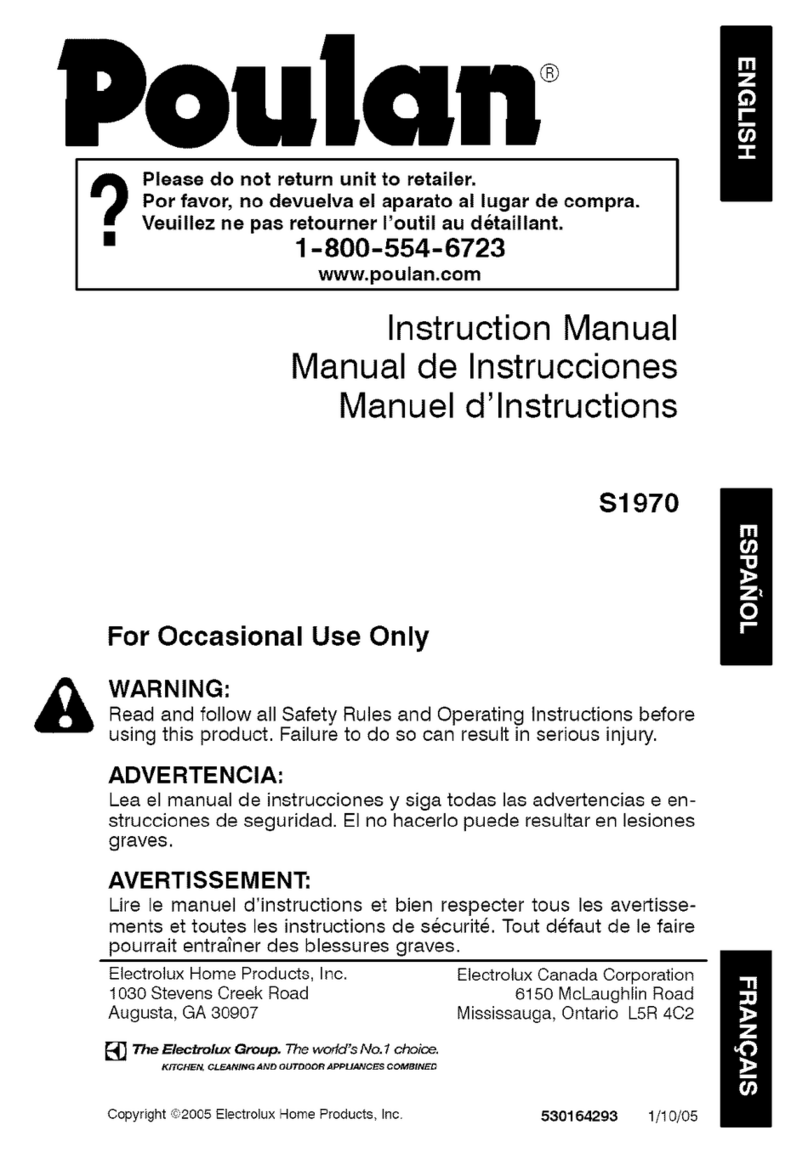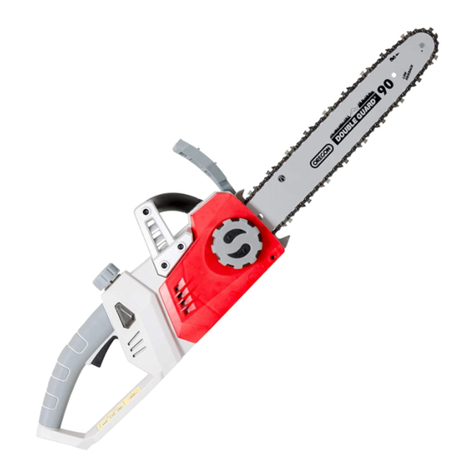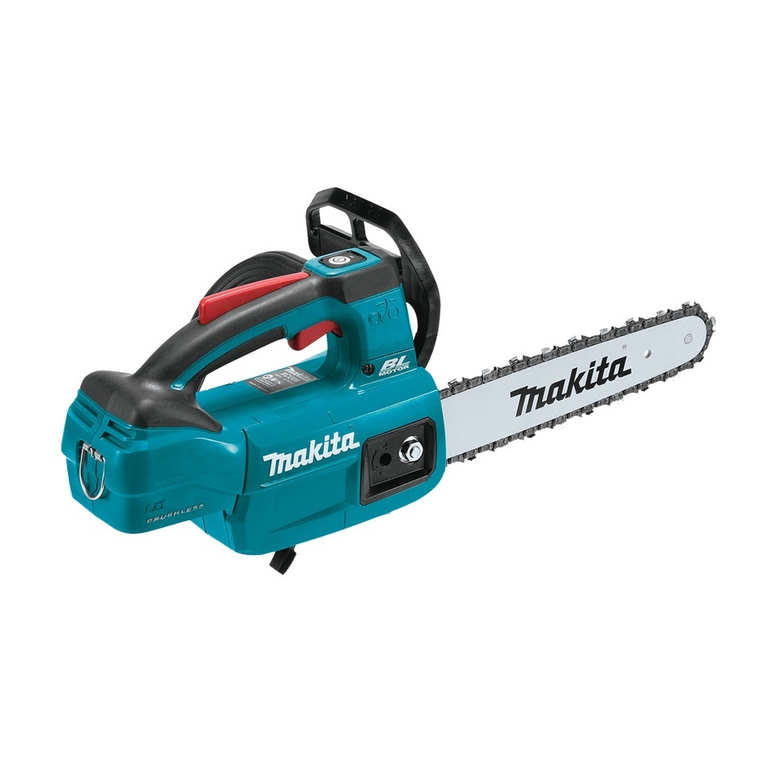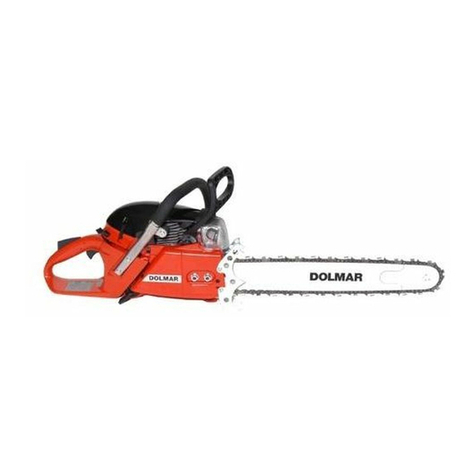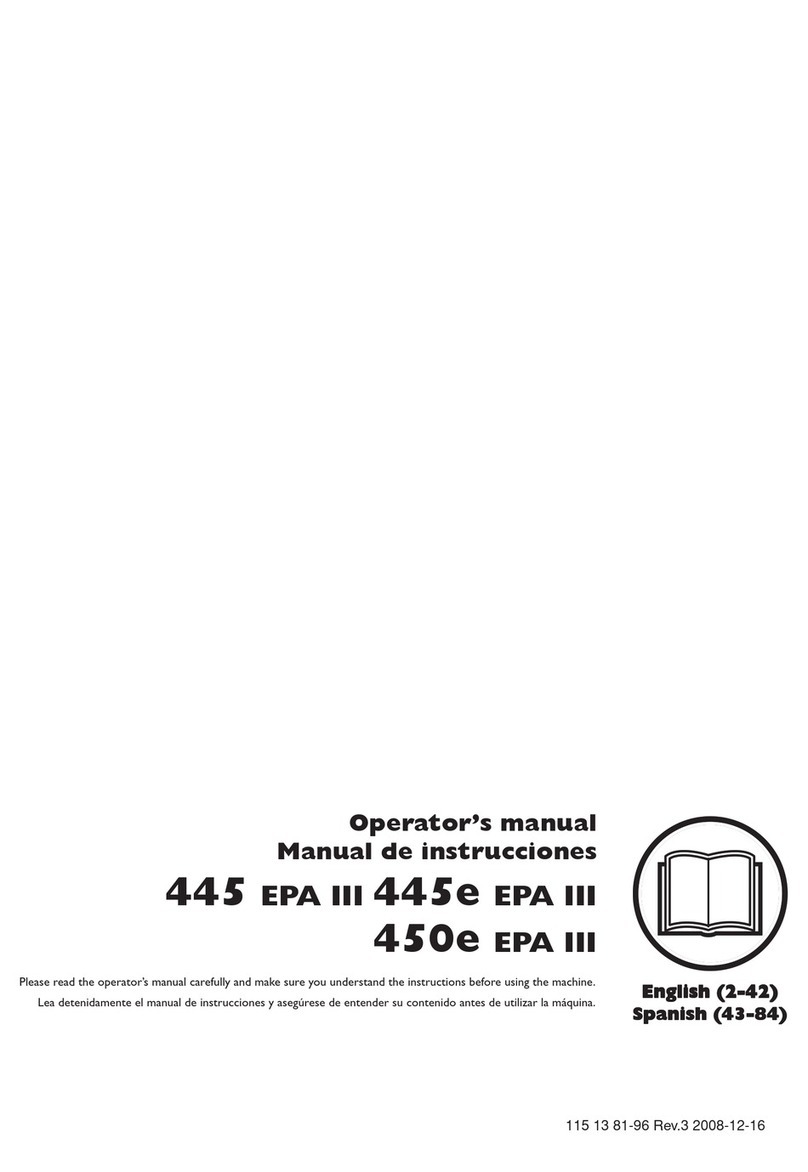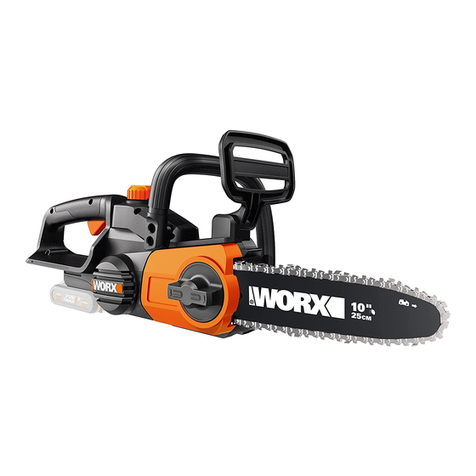prime3 GCS41 User manual

Electric chainsaw
Elektrische Kettensäge
Piła łańcuchowa elektryczna
GCS41
Owner’s manual
Bedienungsanleitung
Instrukcja obsługi

2
IMPORTANT INFORMATION
To achieve the highest satisfaction, enjoy the performance of the
product and learn all its features and functions, please read this
manual before using this product.
Before using the device, read the operating instructions and follow
the instructions contained therein. The manufacturer is not liable for
damages caused by the use of the device contrary to its intended use
or improper operation.
The operating manual should be kept so that it can also be used
during later use of the product.
Safety rules for machinery and electrical equipment.
The device is considered suitable for use in countries with a
moderate, evenly humid climate. It can also be used in other countries.
NOTE! Before installation or using the device, it is absolutely
necessary to read the instruction manual and, in particular, the
recommendations concerning the safety of use. Keep the manual for
inspection and pass it on to the next users of the device.
Failure to follow these safety instructions and warnings can result in
electric shock, fire or serious personal injury.
Do not allow children and adolescents to operate the device. Do not
attempt to install, maintain or use the device if you are not familiar
with the operating instructions.
This equipment is not intended to be operated by individuals with
reduced physical, sensory or mental capabilities or lack of experience
and knowledge of the equipment, unless they have been given
supervision or instruction concerning the use of the equipment by
individuals responsible for their safety.
GCS41

Explanation of warning symbols:
1. Hazard warning. Use extreme caution.
2. Important, read the instructions and observe the warnings.
3. Use safety glasses.
4. Wear safety ear muffs.
5. Always disconnect from the power source before repair or
maintenance. Unplug the device immediately if damaged.
6. Do not use the saw in rain or high humidity conditions.
7. Hold the saw securely and operate it with both hands.
8. Observe the safety rules for kickback. Avoid cutting with the top of
the chain guide bar. If so, the saw is can rotate and may move
towards the operator in an uncontrolled manner causing a risk of
injury.
Workplace safety
Keep the work area clean and well lit. Clutter and poor lighting
contribute to accidents.
Before starting work, prepare and clean the area, remove all stones,
branches, wires, and other foreign objects that pose the risk of
tripping.
Take particular care when working on inclined terrain or slopes.
Do not use the electrically powered device in explosive
environments created by flammable liquids, gases or dusts. The may
generate sparks that can ignite dust or vapours.
Do not use the electric saw in places with an extreme risk of fire or
explosion.
The saw is not waterproof. Operating it in rain or humid
environments may result in electric shock.
3
1 2 3 4
5 6 7 8
GCS41

Children and bystanders should not be allowed in areas where an
electrically powered device is used. Distraction may result in loss of
control of the device. Leave electrically powered garden equipment
away from bystanders.
It is the operator or the user who is responsible for accidents or
hazards to other people or the environment.
Electrical safety
Connect the device only to an electrical supply of characteristics in
accordance with the information on the data plate.
The power tool plugs must match the power sockets. Never alter the
power cord plug in any way. Unmodified plugs and suitable electrical
sockets reduce the risk of an electric shock.
Avoid touching grounded or shorted to ground surfaces such as
piping, radiators, radiators and refrigerators. If parts that are grounded
or shorted to ground are touched, the risk of electric shock increases.
Do not expose electric devices to rain or humid conditions. If water
enters the power tool, the risk of an electric shock increases.
Do not tighten the connection cables. Never use the connection
cable to carry, pull electrical equipment or pull the plug out of the
socket. Keep the connection cable away from heat sources, oils, sharp
edges or moving parts. Damaged or entangled connection cables
increase the risk of an electric shock.
Before starting the work, check the power cord before starting the
work. Do not operate if the power cord or extension cord is abraded,
cut or otherwise damaged. If the power cord is damaged during use,
switch off the device and unplug it from the socket.
If the power tool is used outdoors, the connection cables should be
extended with waterproof extension cords designed to operate
outdoors. Using such an extension cord reduces the risk of an electric
shock. The cross-section area of the extension cord conductors should
be at least 1.5 mm2 when the length of the cable is less than 20 m, and
if the length of the cable is between 20 and 50 m, the minimum cross-
4
GCS41

5
section is 2.5 mm2.
A residual current protection device (RCD) must be used as
protection against shock from the supply voltage. Using the RCD
reduces the risk of electric shock. The equipment should be supplied
through an RCD with a rated current not exceeding 30 mA.
Human safety
Do not start working with a chainsaw if you feel tired or are under
the influence of alcohol, drugs or medication. Full focus is required
when using the device, be careful. A moment of inattention while
using the power tool can lead to an accident and consequently serious
injury or damage to property.
It is necessary to use personal protective equipment. Always wear
eye protection that is close to your face (according to EN 166 or other
national regulations). Wear hearing protectors due to the noise
generated by the device. It is also recommended to use protective
equipment such as a dust mask, anti-slip footwear with uppers,
protective gloves and a helmet.
Clothing should fit closely to the body. Loose clothing, jewellery, a
scarf can be caught in moving parts of the saw, which can lead to
dangerous accidents. If you have long hair it should be secured and
tightened.
When working, the device can eject various objects, sawdust, pieces
of wood at high speed. Risk of injury. It is recommended to use
appropriate clothing.
Remove all wrenches and other set-up tools before operating the
power tool. Leaving a wrench in the rotating part of the power tool
may result in an injury.
Avoid working in an unnatural body position. Adopt a correct and
stable stance to avoid the risk of loss of balance. This will allow better
control of the power tool in unpredictable situations.
Unintentional start-up should be avoided. Before lifting or moving
the device, make sure that the power cord is unplugged from the
GCS41

power supply and the switch is in the off position. Moving electrical
equipment with your finger on the switch or connecting it to the
mains with the switch switched on can lead to an accident.
Keep hands and feet away from moving (rotating) parts of the saw.
Do not raise the working saw above your shoulders. Hold the saw
with both hands.
Keep a safe distance from bystanders.
Despite the safe design and using protective measures and
additional safeguards, there is always a residual risk of injury
during work.
Detailed safety instructions for chainsaws.
Do not attempt to cut metal.
Do not use detergents or alcohol to clean the saw. Wipe with a soft
dry cloth.
Do not use accessories not specifically intended for this device and
recommended by the manufacturer. The fact that some accessories
can be mounted to a power tool is not a guarantee of safe use.
The accessory mounting system must correspond to the dimensions
of the power tool. Tools of improper dimensions cannot be sufficiently
shielded or controlled.
Use personal protective equipment. Depending on the type of work,
wear a protective mask covering the whole face, eye protection, e.g.
safety goggles. Eyes should be protected from airborne foreign matter
ejected during operation. Protect the respiratory tract against dust
and vapours with dust masks. The effects of prolonged exposure to
noise can lead to hearing loss.
Be careful that bystanders are kept at a safe distance from the
working range of the chain saw. Anyone who is close to the operating
power tool must use personal protective equipment. Chips of the
material being cut or cracked work tools can chip and cause injuries
even outside the immediate reach zone.
6
GCS41

7
Never move the power tool when it is in motion. Accidental contact
of clothing with a working tool may cut it and come into contact with
the operator's body.
Regularly clean the device's ventilation slots. The motor blower sucks
dust into the housing and a large accumulation of metal dust can
cause an electrical hazard. Blocked ventilation slots of the device can
also lead to overheating of the power tool.
Before starting each time, make sure that:
- the device is assembled correctly, according to the instructions;
- the cutting tool is in good condition; the chain attachment must be
checked regularly for damage and wear;
- safety devices (e.g. cutter guard, housing, handle, motor switch) are
in good condition and working properly.
Only move the chainsaw away from the workpiece when the cutting
chain is running.
Always use the support claws as a support point when cutting
through. Holding the saw by the main handle, guide it with the
auxiliary handle.
If it is not possible to cut the material at one time, pull the saw
slightly back, move the support claw and continue cutting by lifting
the main handle of the saw slightly.
Be extra careful when the chain gets stuck. This may result in the
kickback towards you.
After the saw is switched off, the chain remains in motion for some
time. Caution must be maintained.
The rotating chain of the saw heats up and expands. Without proper
lubrication and tension, it can jump off the guide bar or break off.
Danger of serious accident and damage to property.
Always turn off the saw when:
- is left unattended;
- before adjustment and maintenance;
- after it being hit by a foreign object;
- abnormal vibrations of the device are sensed.
GCS41

Design of the electric chain saw.
1. Handle 2. Chain lube oil reservoir
3. Chain brake lever 4. Guide bar
5. Chain 6. Guide bar lubrication holes
7. Auxiliary handle 8. Housing
9. Switch lock button 10. Finger guard
11. Power cord 12. Hook for the power cord
13. Air filter housing 14. Chain tensioner (SDS)
15. Transmission guard mounting nut 16. Transmission guard
17. Oil level window 18. Power on/off switch
PREPARING THE MACHINE FOR OPERATION
The chain saw supplied by the manufacturer is partially disassembled. Information on the procedure for
changing the chain, mounting the guide bar, assembly drawings will allow you to assemble and prepare the
saw for work.
CHAIN BRAKE OPERATION
The safety brake is designed to stop the saw chain immediately upon kickback. The brake is ready for use when
it is in a vertical position.
Before each use of the saw, check the operation of the chain brake by moving the lever forward.
8
General information
The device is intended for house gardening use only as described
and protected by these instructions for use. It can be used for pruning
branches, cutting firewood and other applications requiring pruning
of wood.
Other uses can be dangerous to users and can cause damage to the
device. Do not use the device for felling trees, for cutting materials
other than wood and wood-based materials.
GCS41

9
If the brake malfunctions have the saw serviced. Do not use the saw with an inoperative brake.
GUIDE BAR AND CHAIN INSTALLATION
Before installing/removing the guide bar and chain, make sure that the device is unplugged from power
source. Set the chain brake in a vertical position.
Take special care when operating the chain – it is extremely sharp. It is recommended to use protective
gloves.
Before installing the chain and guide bar, check the setting of the direction of the teeth. The saw housing has
an indication of the correct direction.
To remove the chain:
Unscrew the cover holding nut. Remove the transmission cover. Loosen the chain by turning the counter-
clockwise tensioning screw as far as possible. Remove the guide bar and chain.
To install the chain:
Unscrew the cover holding nut. Remove the transmission cover. Loosen the chain by turning the counter-
clockwise tensioning screw as far as possible. Insert the chain into the guide bar groove, paying attention to
the direction of the teeth, so that it corresponds to the indication on the housing.
Put the guide bar and chain onto the fasteners so that the drive links of the chain are in the teeth of the drive
wheel, the screw head in the longitudinal hole of the guide and the pin of the sliding tensioner in the hole of
the guide.
It is recommended to change the position of the guide once every 5 hours of operation so that the upper
edge and the lower edge wear evenly.
Each time, check that the oil passage is clean and ensures free flow.
TENSIONING THE CHAIN
Before starting work, tension the chain. To do so, use the chain tension nut. Tension the chain clockwise.
Check that the chain is inside the slot of the guide.
Tighten the chain clamping screw clockwise until the chain is sufficiently tensioned. Then tighten the locking
nut.
GCS41

10
A properly tensioned chain can be lifted in the middle of the guide bar approx. 3-4 mm up.
CHAIN LUBRICATION
Before starting work, check the oil level for lubricating the chain in the reservoir (2). Top the oil up if it is visible
in the lower part of the check window.
Unscrew the oil tank cap, pour the chain lubrication oil into the oil reservoir. It is recommended that the oil
level fills the entire window of the oil reservoir. After adding oil, tighten the reservoir cap and wipe the body
of the device so that it is free of dirt and slippery.
Check the oil level in the reservoir every 30 minutes of operation.
Do not operate the saw when there is no oil in the reservoir. Chain lubrication oil is not supplied with the
device.
HOW TO TURN THE CHAIN SAW ON AND OFF
Grasp the saw with the right hand by the handle so that it is wrapped around the thumb. Release the chain
brake. Press and hold the lock button with your thumb and press and hold the switch with your index finger.
The saw will start and the chain will rotate.
Release the power switch to turn off the saw. The chain will stop. Engage the chain brake to avoid accidental
start.
SAWING – GENERAL TIPS
Take a 15 minute break after each 15 minutes of work.
Read the safety rules before starting work and cutting. There is a risk of kickback – the saw can kick back
towards you. Danger of serious or fatal accident.
Start cutting when the saw has reached its full speed.
Do not cut through the area around the top quarter of the guide tip.
Do not apply excessive pressure when cutting. Apply gentle pressure when the saw is running at its maximum
speed.
If the guide bar is stuck in the material, do not pull it out by force, use a wedge or lever.
Always ensure that your feet are well supported. Do not stand on logs of trees. Note that
the log being cut may twist.
Be careful of the springing of the branch being cut.
PRUNING
Pruning involves cutting logs and branches from a felled tree.
The branches holding the trunk should be sawn off last only after cutting the trunk.
Tensioned branches should be cut from the bottom to the top to prevent jamming of the saw guide bar.
LOG SLITTING
Consider the direction of stress inside the log. The cut should end on the opposite side of the log bending
direction. This will prevent the guide bar from jamming.
In the case of a tree lying on the ground, make a half-cut, then rotate the log and complete the cut on the
other side.
If the tree is placed on a support on one side, first cut from bottom to top up to 1/3 of the trunk diameter, then
finish cutting the top. If the trunk is supported on both sides, start from the top, cut to 1/3, then finish with a
cut from the bottom.
GCS41

11
TREE FELLING
Before you start felling the tree, you should have a closer look at it. Considering the slope of the tree, the
direction of the wind, the location of heavier branches, the slope of the terrain determine the direction of the
tree fall. Secure the area and make sure whether the falling tree will not cause any damage to the property
nearby. Check the escape route for any obstructions.
Small trees with a diameter of less than 15 cm can be cut with a single cut. If the trunk is thicker make the
felling cut.
Make a cut to 1/3 of the depth of the tree on the side on which the tree is to fall. Make a felling cut slightly
above the opposite side of the cut.
CLEANING AND MAINTENANCE
NOTE! Make sure that the device is switched off and disconnected from the power source before
starting cleaning or maintenance.
After finishing work, the device should be cleaned of debris and dust.
Clean the housing of dust using a delicate brush, paint brush or cloth.
Cleaning with a damp cloth is allowed, but only if the device is dried immediately. Protect metal parts with oil.
Clean the ventilation slots regularly. Use compressed air or a vacuum cleaner.
After every 5 hours of operation, check the condition of the guide bar and chain. Remove sawdust from the
guide bar groove and the oil hole. Lubricate the chain guide sprocket through the guide lubrication hole (6).
Take care that the chain is always sharp. If a blunt chain is used, the guide and other structural components of
the device will wear more quickly. In the extreme situation, the chain may break. It is recommended to have
the chain sharpened by trained professionals.
In case of prolonged storage keep the device in a well-ventilated room, free of moisture and protected from
dust. Make sure to put the guard on the cutting unit and keep the device out of the reach of children.
GCS41

12
Type, model Type, model
Nominal power of the machine 2400 W
Supply voltage and frequency
230 V~50Hz
Guide rail length
40 cm
Chain type
3/8" low profile 0.050"
Number of chain links
52 pcs.
Chain speed
13,5 m/s
Rotational speed without load
7000 rpm
Oil tank capacity
120 ml
0.12 s
Protection class
II
Sound pressure level, measurement uncertainty
LpA=95.5 dB(A), K= 3 dB
The value of vibrations transmitted
by the device and acting
on the upper limbs of the operator
2
front handle a front_hv, eq = 5.682 m/s
2
rear handle a rear_hv, eq = 4.695 m/s
2
K= 1.5m/s
Guaranteed sound power level LWA
107 dB(A)
Weight
4.3 kg
Year built
On the rating label
TROUBLESHOOTING
TECHNICAL DATA
ELECTRIC CHAIN SAW
Chain brake
Schutzart IP
Ip20
GCS41

2N-Everpol Sp. z o.o.
Registered Office:
Puławska 403A
02-801 Warsaw, Poland
Registered office:
Puławska 403A
02-801 Warsaw, Poland
Correspondence address :
Polna 6
05-500 Chyliczki, Poland
Tel +48 22 331 99 59
Fax +48 22 331 99 50
Bank details:
IBAN: PL 97 1160 2202 0000 0000
9062 2569
SWIFT: BIGBPLPW
Bank Millennium S.A
Registration Court: XIII Wydz. Gosp. Sądu Rej. Warszawa
President: Tomasz Jakóbczyk
VAT-No.:
PL9512079512
Bank Account
IBAN: PL 97 1160 2202 0000 0000 9062 2569
SWIFT: BIGBPLPW
Bank Millennium S.A
EC –
DECLARATION OF CONFORMITY
01/2022/GCS41
2N-Everpol Sp. z o.o.
ul. Puławska
403A
02-801 Warsaw
Poland
Authorized person to prepare the technical documentation:
Tomasz Jakóbczyk
ul. Puławska 403A
02-801 Warsaw, Poland
We declare under our sole responsibility that our product:
Type of device:
Electric chain saw
Name:
GCS41
If used for its intended use complies with the
essential protection requirements
relating to the:
2006/42/EC
2014/30/EU
2000/14/EC
(+2005/88/EC)
2011/65/EU
and its Annex II amending directive 2015/863/EU
The assessment of this product has been based on the following standards:
EMC
standards:
EN 61000-3-2:2014
EN 61000-3-11:2000
EN 55014-1:2017+A11:2020
EN 55014-2:2015
MD and
LVD
standards:
EN ISO 12100:2010
EN
60745-1:2009+A11:2010
EN 60745-2-13:2009+A1:2010
RoHS
standards:
EN IEC 63000:2018
Conformity assessment method used
2000/14/EC and amended by 2005/88/EC
Annex V
Sound power level dB (A)
Measures sound power level (LPA): 95,5 dB(A), KpA: 3,0 dB(A)
Guaranteed sound power level (LWA): 107
dB(A)
Warsaw, 25.07.2022

14
WICHTIGE HINWEISE
Bitte lesen Sie diese Gebrauchsanweisung, bevor Sie das Gerät in
Betrieb nehmen, damit Sie die Leistung des Geräts voll ausschöpfen
und alle Funktionen kennen lernen können.
Bevor Sie das Gerät benutzen, lesen Sie die Gebrauchsanweisung
und befolgen Sie die darin enthaltenen Anleitungen. Der Hersteller
haftet nicht für Schäden, die durch nicht bestimmungsgemäßen
Gebrauch oder unsachgemäße Handhabung des Gerätes entstehen.
Die Gebrauchsanweisung sollte so aufbewahrt werden, dass sie auch
bei der späteren Verwendung des Produkts verwendet werden kann.
Sicherheitsvorschriften für Maschinen und elektrische Geräte
Das Gerät ist für den Einsatz in Ländern geeignet, in denen das Klima
moderat und gleichmäßig feucht ist. Es kann auch in anderen Ländern
verwendet werden.
ACHTUNG! Bevor Sie das Gerät installieren oder benutzen, müssen
Sie unbedingt die Gebrauchsanweisung und insbesondere die
Sicherheitshinweise lesen. Bewahren Sie diese Gebrauchsanweisung
zum Nachschlagen auf und geben Sie sie an zukünftige Benutzer des
Geräts weiter.
Die Nichtbeachtung dieser Sicherheits- und Warnhinweise kann zu
Stromschlag, Feuer oder schweren Verletzungen führen.
Lassen Sie Kinder und Jugendliche das Gerät nicht bedienen.
Personen, die nicht mit der Gebrauchsanweisung vertraut sind, sollten
nicht versuchen, das Gerät zu installieren, zu warten oder zu
verwenden.
Dieses Gerät ist nicht dafür bestimmt, durch Personen mit
eingeschränkten physischen, sensorischen oder geistigen Fähigkeiten
oder mangels Erfahrung oder mangels Wissen über das Gerät benutzt
zu werden, es sei denn, sie werden durch eine für ihre Sicherheit
DEUTSCH
GCS41

zuständige Person beaufsichtigt oder erhielten von ihr Anweisungen
zur Benutzung.
Erläuterung der Warnsymbole:
1. Gefahrenwarnung. Seien Sie besonders vorsichtig.
2. Wichtig, lesen Sie die Gebrauchsanweisung durch und beachten Sie
die Warnhinweise.
3. Schutzbrille tragen.
4. Ohrenschützer tragen.
5. Vor Reparatur oder Wartung immer von der Stromquelle trennen.
Wenn das Kabel beschädigt ist, ziehen Sie sofort den Stecker aus
der Steckdose.
6. Verwenden Sie die Säge nicht bei Regen oder Feuchtigkeit.
7. Die Säge sollte sicher gehalten und mit beiden Händen bedient
werden.
8. Beachten Sie die Sicherheitsvorschriften bezüglich des Rückstoßes.
Vermeiden Sie es, mit der Oberseite der Kettenführung zu
schneiden. In diesem Fall neigt die Säge dazu, sich zu drehen und
kann sich unkontrolliert auf den Bediener zubewegen, was zu einer
Verletzungsgefahr führen kann.
Sicherheit am Arbeitsplatz
Halten Sie den Arbeitsbereich ordentlich und gut beleuchtet.
Störungen und schlechte Beleuchtung tragen zu Unfällen bei.
Vor Arbeitsbeginn den Bereich vorbereiten und reinigen, alle aus
dem Boden herausragenden Steine, Äste, Drähte und andere
Fremdkörper entfernen, bei denen Stolpergefahr besteht.
Seien Sie besonders vorsichtig, wenn Arbeiten auf abschüssigem
15
1 2 3 4
5 6 7 8
GCS41

Gelände oder Hängen durchgeführt werden.
Verwenden Sie ein elektrisch betriebenes Gerät nicht in
explosionsgefährdeten Bereichen, die durch brennbare Flüssigkeiten,
Gase oder Stäube entstehen. Das Gerät kann Funken erzeugen, die
Staub oder Dämpfe entzünden können.
Verwenden Sie die elektrische Säge nicht an Orten mit extremer
Brand- oder Explosionsgefahr.
Die Säge ist nicht gegen Wasser geschützt. Arbeiten in Regen- oder
feuchten Umgebungen können zu einem Stromschlag führen.
Kinder und Beobachter sollten nicht an Orten zugelassen werden, an
denen ein elektrisch betriebenes Gerät verwendet wird. Ablenkung
kann zum Verlust der Kontrolle über das Gerät führen. Halten Sie
elektrisch betriebene Gartengeräte von Umstehenden fern.
Für Unfälle oder Gefahren, die anderen Personen oder der Umwelt
entstehen, ist der Betreiber oder Benutzer verantwortlich.
Elektrische Sicherheit
Schließen Sie das Gerät nur an eine Steckdose an, deren
Eigenschaften mit den Werten auf dem Typenschild übereinstimmen.
Die Stecker von Elektrowerkzeugen müssen in die Steckdosen
passen. Der Stecker des Netzkabels darf auf keinen Fall verändert
werden. Unveränderte Stecker und geeignete Steckdosen verringern
die Gefahr eines Stromschlags.
Vermeiden Sie das Berühren von geerdeten oder kurzgeschlossenen
Oberflächen wie Rohren, Heizungen, Heizkörpern und Kühlschränken.
Wenn Sie Teile berühren, die geerdet oder kurzgeschlossen sind,
erhöht sich das Risiko eines Stromschlags.
Setzen Sie elektrisch betriebene Geräte nicht dem Regen oder Nässe
aus. Wenn Wasser in das Elektrowerkzeug eindringt, erhöht sich das
Risiko eines Stromschlags.
Die Anschlusskabel nicht festziehen. Benutzen Sie das
Anschlusskabel niemals, um ein elektrisch betriebenes Gerät zu
tragen, zu ziehen oder den Stecker aus der Steckdose zu ziehen.
16
DEUTSCH
GCS41

Halten Sie das Anschlusskabel von Wärmequellen, Ölen, scharfen
Kanten oder beweglichen Teilen fern. Beschädigte oder verwickelte
Anschlusskabel erhöhen das Risiko eines Stromschlags.
Überprüfen Sie vor Beginn der Arbeiten das Netzkabel. Nehmen Sie
das Gerät nicht in Betrieb, wenn das Netzkabel oder das
Verlängerungskabel abgenutzt, durchgeschnitten oder anderweitig
beschädigt ist. Wenn das Netzkabel während des Gebrauchs
beschädigt wird, schalten Sie das Gerät aus und ziehen Sie den Stecker
aus der Steckdose.
Wenn das Elektrowerkzeug im Freien verwendet wird, verlängern Sie
die Anschlusskabel mit wasserdichten Verlängerungskabeln, die für
die Verwendung im Freien vorgesehen sind. Die Verwendung eines
solchen Verlängerungskabels verringert die Gefahr eines
Stromschlags. Der Querschnitt des Verlängerungskabels sollte
mindestens 1,5 mm2 betragen, wenn die Kabellänge weniger als 20 m
beträgt, und wenn die Kabellänge zwischen 20 und 50 m beträgt,
sollte der Mindestquerschnitt 2,5 mm2 betragen.
Fehlerstromschutzschalter (RCD) sollten als Schutz gegen
Stromschlag durch die Versorgungsspannung verwendet werden. Die
Verwendung eines RCD verringert die Gefahr eines Stromschlags. Das
Gerät muss über einen Fehlerstromschutzschalter mit einem
Nennstrom von nicht mehr als 30 mA versorgt werden.
Menschliche Sicherheit
Arbeiten Sie nicht mit einer Kettensäge, wenn Sie sich müde fühlen
oder unter dem Einfluss von Alkohol, Drogen oder Medikamenten
stehen. Bei der Verwendung des Geräts ist vollständige Fokussierung
erforderlich. Ein Moment der Unachtsamkeit bei der Verwendung des
Elektrowerkzeugs kann zu einem Unfall und damit zu schweren
Verletzungen oder zum Verlust von Eigentum führen.
Es ist notwendig, persönliche Schutzausrüstung zu verwenden.
Tragen Sie immer eine Schutzbrille, die eng am Gesicht haftet (gemäß
EN 166 oder anderen nationalen Vorschriften). Aufgrund der
17
GCS41

18
DEUTSCH
Lautstärke des Gerätes sollte Gehörschutz getragen werden. Das
Tragen von Schutzausrüstung wie Staubmaske, rutschfesten
Sicherheitsschuhen mit Oberteil, Schutzhandschuhen und einem Helm
wird ebenfalls empfohlen.
Tragen Sie eng anliegende Kleidung. Lose Kleidung, Schmuck und
Schals können von den beweglichen Teilen der Säge erfasst werden,
was zu gefährlichen Unfällen führen kann. Wenn der Benutzer lange
Haare hat, sollten diese gesichert und gebündelt werden.
Während des Betriebs kann die Maschine verschiedene
Gegenstände, Sägemehl und Holzstücke mit hoher Geschwindigkeit
auswerfen. Es besteht Verletzungsgefahr. Es wird empfohlen,
geeignete Kleidung zu verwenden.
Entfernen Sie vor dem Starten des Elektrowerkzeugs alle
Schraubenschlüssel und anderen Werkzeuge, die zum Einstellen des
Elektrowerkzeugs verwendet werden. Das Belassen des Schlüssels im
rotierenden Teil des Elektrowerkzeugs kann zu Verletzungen führen.
Vermeiden Sie es, in einer unnatürlichen Körperhaltung zu arbeiten.
Nehmen Sie eine korrekte und stabile Haltung ein, um einen
Gleichgewichtsverlust zu vermeiden. Dies ermöglicht eine bessere
Kontrolle des Elektrowerkzeugs in unvorhersehbaren Situationen.
Vermeiden Sie unbeabsichtigte Inbetriebnahme. Vergewissern Sie
sich, dass das Netzkabel vom Stromnetz getrennt und der Schalter
ausgeschaltet ist, bevor Sie das Gerät anheben oder bewegen. Das
Tragen von elektrisch betriebenen Geräten mit dem Finger auf dem
Schalter oder das Anschließen an das Stromnetz bei eingeschaltetem
Schalter kann zu einem Unfall führen.
Halten Sie Hände und Füße von beweglichen (rotierenden) Teilen der
Säge fern.
Heben Sie die im Betrieb befindliche Säge nicht über Ihre Schultern.
Halten Sie die Säge mit beiden Händen.
Halten Sie einen sicheren Abstand zu umstehenden Personen.
GCS41

19
Trotz einer inhärent sicheren Konstruktion, der Anwendung von
Sicherheitsmaßnahmen und zusätzlichen Schutzmaßnahmen
besteht bei der Arbeit immer ein Restrisiko für Verletzungen.
Ausführliche Sicherheitshinweise für Kettensägen.
Versuchen Sie nicht, Metall zu schneiden.
Verwenden Sie keine Reinigungsmittel oder Alkohol, um die Säge zu
reinigen. Mit einem weichen, trockenen Tuch abwischen.
Verwenden Sie nur Ausrüstung, die speziell für dieses Gerät
entwickelt wurde und vom Hersteller empfohlen. Die Tatsache, dass
das Gerät an ein Elektrowerkzeug montiert werden kann, ist keine
Garantie für eine sichere Verwendung.
Das Befestigungssystem des Werkzeugs muss den Abmessungen des
Elektrowerkzeugs entsprechen. Unsachgemäß dimensionierte
Werkzeuge können nicht ausreichend abgeschirmt oder kontrolliert
werden.
Es muss eine persönliche Schutzausrüstung verwendet werden.
Tragen Sie je nach Art der Arbeit eine Schutzmaske, die das ganze
Gesicht bedeckt, Augenschutz bzw. eine Schutzbrille. Schützen Sie Ihre
Augen vor Fremdkörpern in der Luft, die bei der Arbeit entstehen.
Schützen Sie die Atemwege mit Staubmasken vor aufsteigendem
Staub und Dämpfen. Lärmbelastung über einen längeren Zeitraum
kann zu Hörverlust führen.
Halten Sie Unbeteiligte in einem sicheren Abstand zum Bereich der
Kettensäge. Jeder, der sich in der Nähe eines arbeitenden
Elektrowerkzeugs aufhält, muss eine persönliche Schutzausrüstung
tragen. Splitter von Werkstücken oder zerbrochene Arbeitsgeräte
können auch außerhalb des unmittelbaren Greifbereichs absplittern
und Verletzungen verursachen.
Tragen Sie das Elektrowerkzeug nicht, wenn es in Bewegung ist. Bei
versehentlichem Kontakt der Kleidung mit dem Arbeitsgerät kann die
Kleidung einschneiden und mit dem Körper des Benutzers in
Berührung kommen.
GCS41

20
DEUTSCH
Reinigen Sie regelmäßig die Lüftungsschlitze des Geräts. Das
Motorgebläse saugt Staub in das Gehäuse und große Ansammlungen
von Metallstaub können zu einer elektrischen Gefahr führen. Eine
blockierte Belüftung des Geräts kann auch zu einer Überhitzung des
Elektrowerkzeugs führen.
Überprüfen Sie vor jeder Inbetriebnahme, dass:
- das Gerät entsprechend den Anweisungen korrekt montiert ist;
- das Schneidwerkzeug in einwandfreiem Zustand ist; die Befestigung,
Beschädigung und der Verschleiß der Kette müssen regelmäßig
überprüft werden;
- die Sicherheitseinrichtungen (z. B. Schneidschutz, Gehäuse, Griff,
Motorschalter) in einwandfreiem Zustand sind und einwandfrei
funktionieren.
Bewegen Sie die Kettensäge nur bei laufender Schneidkette von dem
zu schneidenden Material weg.
Benutzen Sie beim Durchschneiden immer die Klaue des
Hinterschaftes als Drehpunkt.
Halten Sie die Säge am Hauptgriff und führen Sie sie mit dem Hilfsgriff.
Halten Sie die Kettensäge am Hauptgriff und führen Sie sie mit dem
Hilfsgriff.
Sollte es nicht möglich sein, das Material in einem Zug zu
durchtrennen, ziehen Sie die Säge leicht zurück, positionieren Sie die
Klaue des Stützpfeilers neu und setzen Sie den Schnitt fort, indem Sie
den Hauptgriff der Säge leicht anheben.
Seien Sie besonders vorsichtig, wenn die Kette klemmt. Dies kann
zum sog. Rückstoß an den Benutzer führen.
Nach dem Abschalten der Säge bleibt die Kette noch einige Zeit in
Bewegung. Seien Sie besonders vorsichtig.
Die rotierende Kette der Säge erwärmt sich und dehnt sich aus. Ohne
richtige Schmierung und Spannung kann sie von der Führung
springen oder abbrechen. Gefahr von schweren Unfällen und Verlust
GCS41
Table of contents
Languages:
